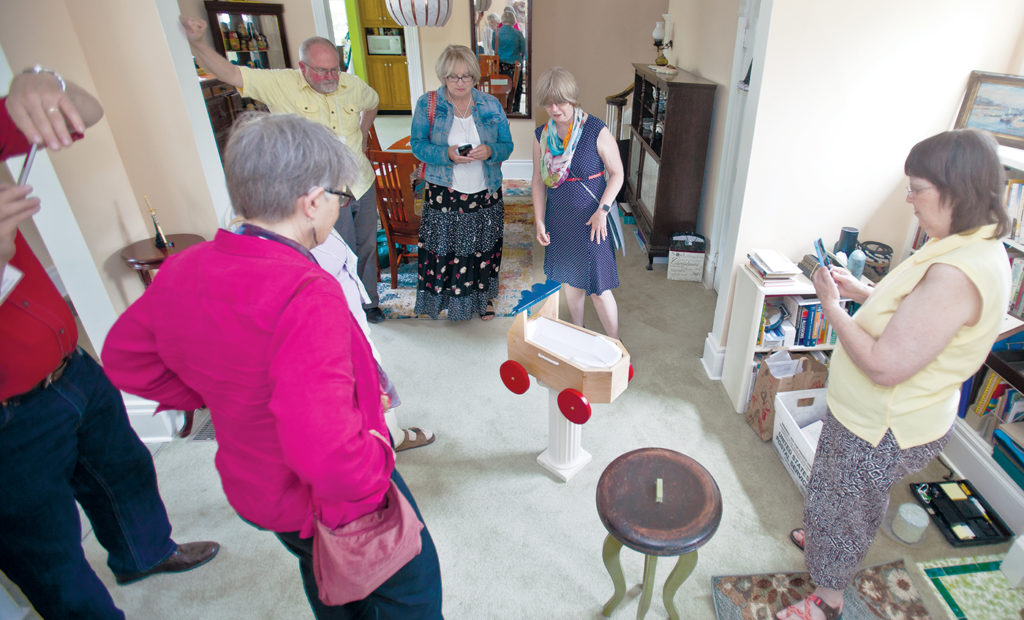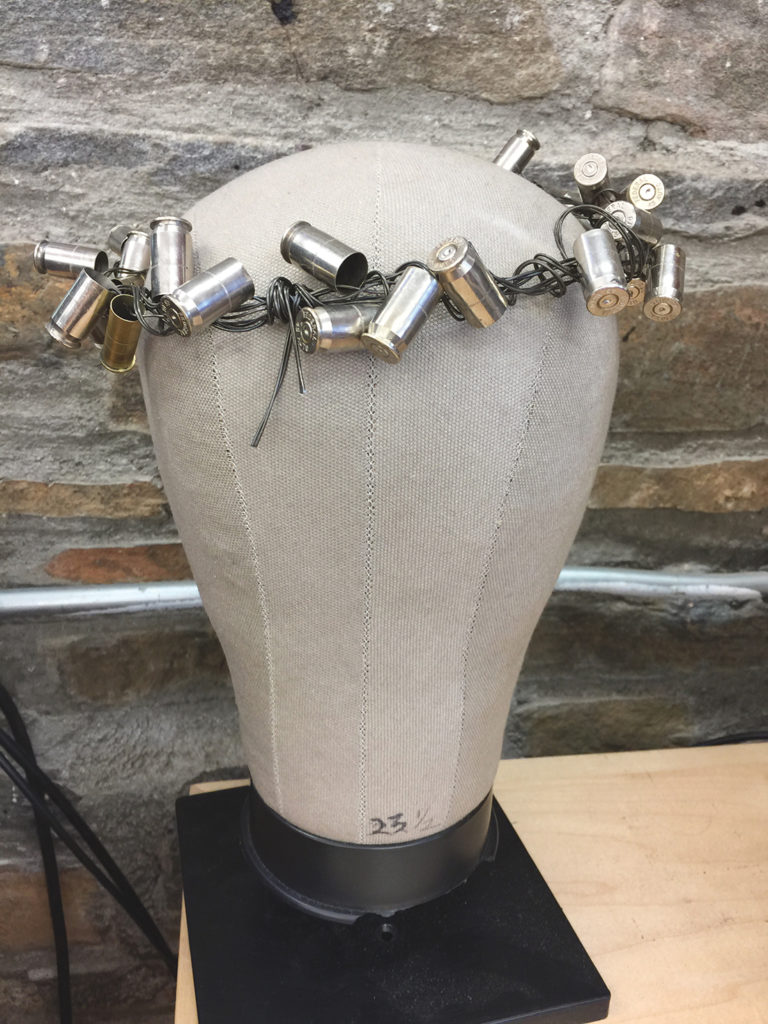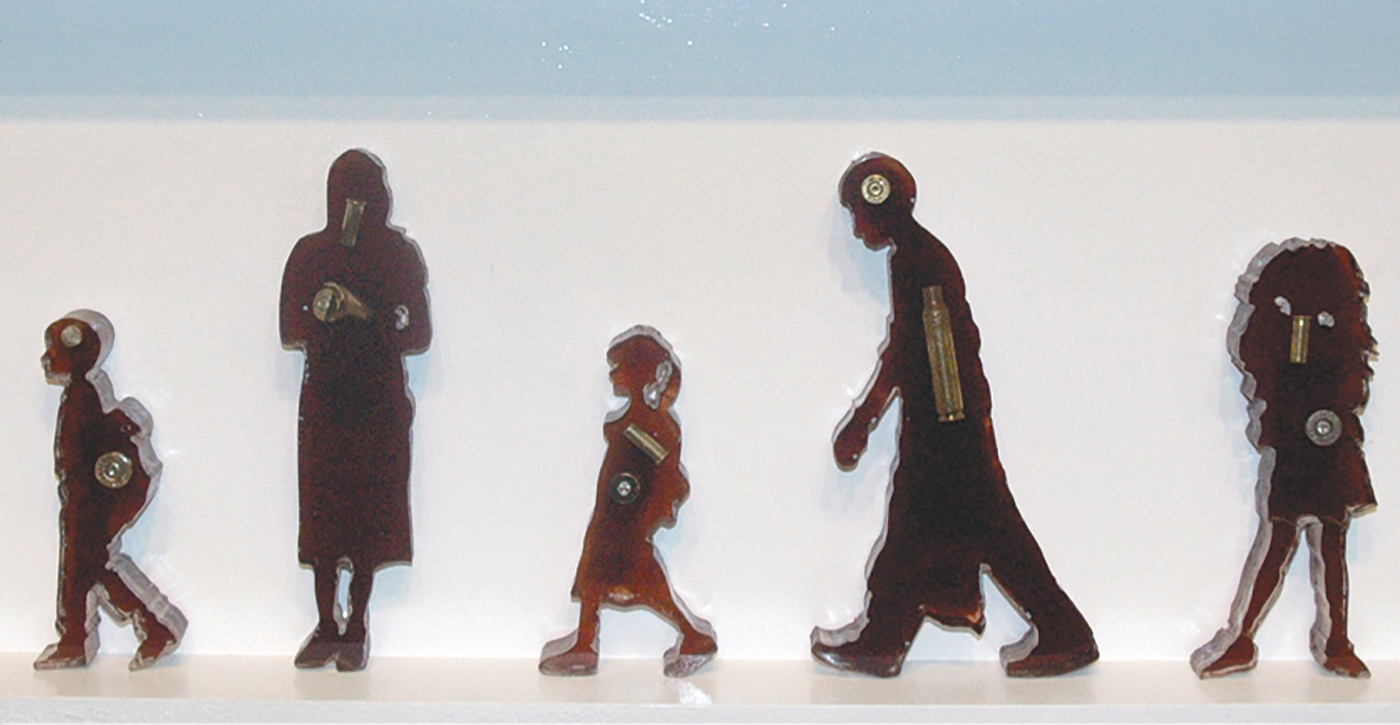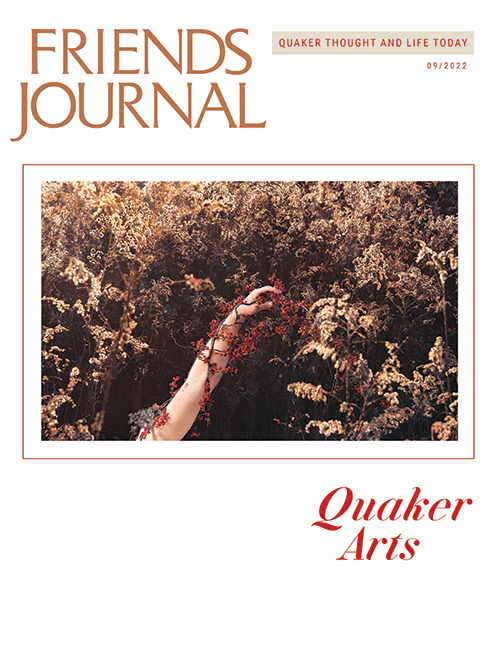The Theopoetics of Beating Swords into Plowshares
He shall judge between the nations,
and shall arbitrate for many peoples;
they shall beat their swords into plowshares,
and their spears into pruning hooks;
nation shall not lift up sword against nation,
neither shall they learn war any more.
—Isaiah 2:4
I became an artist when I began to perform acts of aesthetic fury to decry gun violence. My experiments began while I was Plowshares professor of Peace Studies at Earlham College in Richmond, Indiana. I wrote a grant to work with a metalsmith to teach me how to beat a sword into a plowshare because, given my title, I thought it would be a good thing to know. The metalsmith I worked with, Sungyeoul Lee, quickly persuaded me that lost-wax casting would be a far-more accessible technique than forging.
The first step in the project was collecting bullet shells to melt for the casting. The local police department provided me with 100 pounds of spent shells from their practice firing range. I also asked for and received spent NATO shells from a colleague who worked with ROTC programs at Michigan Technological University in Houghton.
Front (left) and back (right): Welling Hall, Swords into Plowshares, 8″ x 3″ x 0.5″; bullet shells. These garden shears are made from
shells, with combat knives for blades.
I decided to make garden shears out of the shells, with combat knives for blades. I wanted the brutality and the death implied by the bullet shells to resolve into something organic and growing in opposition to the horror. The design for the shears incorporated echoes of lotus flowers I had seen after leaving the Tuol Sleng Genocide Museum in Phnom Penh, Cambodia. The shears took three weeks to make, working under the constant supervision of a mentor for 40 hours a week: drawing, carving, refining, weighing, melting, casting, grinding, sanding, soldering, machining, riveting, engraving, and polishing (and likely some processes I have forgotten). My mind and body were completely focused on the same task: they had to be. Some aspects of the process were physically dangerous, such that if I had taken my mind off of the work I would have been injured. I learned the hard way that if you want to make shears, starting with bullet shells is impractical, but it can be done. But more important than the efficiency quotient, I made something real and beautiful out of things I believe are obscene. The shape and aesthetics of the garden shears are ambiguous (what are these?), especially from the side where a bullet shell is used as a rivet. I believe that ambiguity prompts emotional engagement. The shears do this prompting without words.
I needed another project to work on during moments when the shears project needed to be at rest. That year the United Nations was at work on the Arms Trade Treaty for regulating trade of conventional weapons. Oxfam International was producing media spots that highlighted the world’s production of nearly two bullets per person every year. I intended to illustrate the precision, the insanity, the violence, and the racism of producing that many bullets. My project involved processes and methods to find vector images and laser cut them out of acrylic, stack layers of acrylic cut-outs, make high-resolution silicone molds of the acrylic cut-outs, fill the molds with toxic resin, embed the bullet shells when the resin was partially set, color the final layer of resin, demold the resin, sand for weeks with progressively finer grades of sandpaper, make a frame, and problem-solve how to affix the finished figures to the frame.

Welling Hall, Two Bullets per Person, 31″ x 10″ x 2.5″; resin, bullet shells, medium-density fiberboard.
I believe this is a transgressive piece that crosses boundaries and breaks down categories. The piece works with the phrase “two bullets per person” to suggest that each person—and in this instance, each brown person—has two bullets assigned to them. These abstract bullets are made concrete and visible in the sculpture. Two things happened after I finished the work. The first occurred when I entered the piece into an art show for the first time: a student asked me if I was an artist, and I realized that I am. The second was my discovering the piece generated far more interest in the proliferation of weapons than any academic paper I had ever written. Two Bullets per Person was the last sculpture I made as a professor of politics and peace studies.
Sculpture number three was made several years later at Penland School of Craft in Spruce Pine, North Carolina. I was in a wood workshop, and the assignment was to make a sculpture that included a box shape. This was about two months after the 2018 mass shooting at Stoneman Douglas High School in Parkland, Florida. I noted that coffins are box-shaped and thought about the children living in a world in which school shootings were normative. I was thinking also about kids’ toys and about how children play with toys in order to live into their imaginations. The idea arose of making a play coffin in order to live, awfully, into a world in which it is okay to be the victim of a school shooting.

Welling Hall, Thoughts and Prayers, 15.5″ x 19″ x 13″; hard maple, milk paint, satin, foam, rifle bullet. This consists of a coffin on wheels for a base and a wooden toy assault rifle for a handle.
I settled on a sculpture that was modeled on a toddler’s push toy: a coffin on wheels for a base and a wooden toy assault rifle for a handle. The sculpture is made out of hard maple, the same material that is used for high-quality children’s toys, and lined with the satin upholstery used in coffins. The rifle is dark blue and the wheels are bright red, both painted with hand rubbed, nontoxic milk paint. The title, Thoughts and Prayers, is the last aspect of the artwork that came to me. I know it works with the kind of ambiguity I aspire to because many viewers initially ask if I made it for a grandchild or a child I know.

Welling Hall, Untitled, 10″ x 12″ x 10″; bullet shells, iron wire.
The fourth piece is the most conventionally theological of my Swords into Plowshares sculptures and remains untitled. I created a crown of thorns in which the “thorns” are bullet shells. In contrast to the first three works which took weeks to create (either in the conception, implementation, or both), Untitled came together very quickly. I believe the piece is less powerful than Two Bullets per Person or Thoughts and Prayers because it doesn’t show how the public execution of Jesus is connected to gun violence and mass shootings. Perhaps viewers need to be fully embedded within Christian imagery to see the reference. Also, aside from the substitution of bullet shells for thorns, there is nothing particularly boundary crossing or ambiguous about the piece. Speaking from a theopoetics perspective, the piece doesn’t succeed in latching onto an alternative image in the name of God.
He shall judge between many peoples,
and shall arbitrate between strong nations far away;
they shall beat their swords into plowshares,
and their spears into pruning hooks;
nation shall not lift up sword against nation,
neither shall they learn war any more.
—Micah 4:3
Micah repeats Isaiah’s words, or perhaps it is the other way around. In either case, the root metaphor is repeated. Artists find multiple ways to nurture prophetic imagination. The dominant culture has accepted wars and gun violence in ways too numerous to count, inflicting trauma on individuals and generations.
Transforming weapons into agricultural tools has seized the prophetic imagination for millennia. Beating a sword into a plowshare both is and is not a metaphor. The powerful act of forging hot metal—of using will and muscle to destroy a destroyer—is also a generative metaphor about waging peace. With their physical acts and embodied testimony, artists practice theopoetics, engaging in God’s world and God’s Word by making it be so.
Volumes of theology have been drafted for the task of rationalizing arguments for war and evaluating whether war has been conducted justly. In contrast, the theology and theopoetics at work in Isaiah 2:4 focus on creating life where death and suffering have been the rule. These verses do not envision the return to an idyllic past; they envision a new ordering for creation that must be made. The task of theopoetics is to disclose an unknown world of life to a world that is fascinated by death. What language can it speak? Finding a way to articulate the unspeakable (either because it burns too close to the wick or because, being unknown and unknowable, we are in the land of the ineffable) is the challenge of theopoetics.
Synchronistically brain science tells us that in trauma (or during flashbacks of traumatic events), the part of the brain that governs speech in the left hemisphere shuts down. In trauma, there are quite literally no words. One of the consequences of war is that people, perhaps even generations of people, are traumatized. Society falters, its entire imagination consumed by war and preparation for war; peace is dis-imagined, even unspeakable. Perhaps our reception of peace also lies outside the boundary of normal consciousness, an alternative consciousness is needed in order to see or hear a world that does not yet exist.
Seeing or hearing a world that does not yet exist is what artists aim for in creating physical testimony. Bearing social witness and operating outside of rational discourse, artists enact and embody an aesthetic response to a moral demand. We might wonder if the (visual) arts work in part precisely because they are nonverbal and therefore ideally suited to circumventing the rational mind. Perhaps the nonverbal arts can embody a moment of transfiguration before that moment can be expressed any other way, or simply, because faith cannot be as successfully expressed in words.
Quaker theologian William Taber gets at something of this shared concern when he writes about not talking about faith. In his Pendle Hill pamphlet The Prophetic Stream, Taber notes that “the modern mind has been out of touch with our intuitive ability to feel nonverbal religious reality” (emphasis added). In claiming the power of the nonverbal, Taber celebrates prophets or seers: those “who see deep into the nature of things and see patterns of order which the rest of us cannot yet see.”
It is well-established that trauma messes with time and with words. Time crumples, elongating or squeezing in order to maximize suffering. Words fail. Theopoetics engages the nonverbal in order to circumvent the rational mind lodged in the dominant imaginary. In completing this project, I am learning that something has also happened with time in my creative interpretation of beating a sword into a plowshare. Just as I can look at my grown son and feel the infant boy in my arms, when I think about the aesthetic fury that engaged all of my embodied knowing, I imagine that I made this art yesterday. Time vanishes. Perhaps a theopoetic moment is like a labyrinth set apart from the temporal world in which we attempt to see God deep at the center, moving sometimes nearer, sometimes further away, but always seeking.







I was looking up information on International Day for the Total Elimination of Nuclear Weapons, 26 September. Just before I opened the FJ email, I saw a photo of a sculpture, “Good Defeats Evil”, on this website:
https://www.un.org/en/observances/nuclear-weapons-elimination-day
The sculpture depicts St. George slaying the dragon. The dragon is created from fragments of Soviet SS-20 and United States Pershing nuclear missiles.
Art is a powerful way of communication, of expression and creation.
Thank you, Friends Journal, for your series of articles on Art.